Abstract
During COVID-19, the traditional educational landscape witnessed the rapid and unprecedented adoption of modern communication methods to facilitate remote learning and academic interactions. Various online education platforms have enriched content deliveries, paved the way for learners across the globe, and enriched the learning environment for learners and facilitators who design, deliver, and try their best to make it exciting and engaging. Apart from this, even the traditional mode of education encourages the use of blended and hybrid learning so that deliverables are improved. Advancement in the usage of hybrid, innovative smart classes is encouraged by higher educational institutions. This study delves into the paradigm shift in higher education brought about by the COVID-19 pandemic, explicitly focusing on the transformation of communication methods. It also focuses on the various effective communication methods (online and physical classes) that higher education institutions adopt. This study considers secondary data and argues on online learning skills, classroom learning/flipped classroom method, problem-based learning, cooperative learning, assessment evaluation techniques, the four-quadrant approach, and outcome-based teaching–learning pedagogy for all higher education programs. Furthermore, the research considers the long-term impact of these modern communication methods on the future of higher education. It explores whether adopting these technologies will persist or evolve as institutions transition back to in-person learning and whether a blended approach to education will emerge. In conclusion, this research provides a timely assessment of the transformation of communication methods in higher education post-COVID-19, shedding light on the opportunities, challenges, and potential pathways for the sustainable integration of modern communication methods in the academic realm.
1. Introduction
SinceCOVID-19, higher education institutions worldwide have been experimenting with modern methods to improve learning styles and evaluation systems to effectively communicate with students, parents, industry experts, academia, and others for student development. The goal was to improve education by emphasizing student-centered learning over teacher-centered dialogues. The purpose was to monitor and measure student learning. Physical obstacles, a lack of software support in organizations linking remote places, and slow internet access prevented this from being quickly implemented internationally. Government educational agencies worldwide developed and implemented measures to improve educational quality. Since COVID-19, online learning, classroom learning/flipped classroom methods, problem-based learning, cooperative learning, assessment evaluation approaches, and outcome-based teaching–learning methodology have been effective in higher education [1,2,3,4,5].
1.1. Effective Modern Communication Methods and Challenges
In higher education institutions, online education is called e-learning or online classes [6]. However, the COVID-19 pandemic changed the scenario. It gave a broader picture of online education with various tools used in modern education. Modern online teaching tools also support classroom teaching. Online education was launched in the 1900s and progressed slowly in rich countries but became global during the COVID-19 pandemic [7], now acquiring the place as essential. Online education teaching–learning pedagogy has broken down all barriers to conventional learning, allowing students to register for courses online and learn concepts and content at their convenience [8]. During the pandemic, online student learning was initially tricky [9] as everyone was unprepared for the pandemic’s effects on education and its different fronts [10]. Since “necessities are the mother of innovations” and learning could not be stopped, IT and academic professionals created online platforms and new methods to distribute knowledge to students. Academics were uncomfortable with the move initially because of their practices in traditional ways of teaching. However, modern approaches and professionals made it possible and comfortable for all involved. Virtual whiteboards, recorded tutorials, learning management systems, synchronous and asynchronous discussion boards, evaluation approaches, and blended learning are effective online education methods that widen space with time. The few challenges stated and discussed are:
1.1.1. Challenges (Tutors)
Faculty have a crucial role in creating all sorts of content and the biggest obstacle for them is obtaining online-friendly and up-to-date infrastructural support for producing e-content and e-tutorials, distributing content, and providing a trustworthy online infrastructure. Sometimes, difficulties arise because of limited experience with online learning platforms. Dealing with many learners from diverse backgrounds within a limited time period is also a challenge for faculties dealing with online or hybrid settings.
1.1.2. Challenges (Learners)
Learners’ most significant challenge in online education is span of concentration. Sometimes, this may be attributed to poor learning tools, hardware, and technical assistance. If students need help understanding the concepts taught in online classes, they get sidetracked, which causes challenges for quality education delivery.
1.1.3. Challenges (Administration)
In the online and hybrid forms of education, administrative tasks include the management of finances, the planning and implementation of methods for all students at the same pace and time, efficient utilization of the online education system in terms of infrastructure, and the monitoring of all learners and stakeholders; these tasks are challenges for the administrators of institutions.
2. Materials and Methods
This research uses data collected from different secondary sources, and the research method is descriptive. Researchers have looked at the qualitative aspects of the study. This study is based entirely on secondary data. The secondary data sources used were: (a) journals, (b) reports, (c) search engines, (d) company websites and scientific articles, and (e) research papers, among other academic publications.
3. Discussion and Interpretation
3.1. Communication Methods Adopted during COVID-19
3.1.1. Flipped Classroom: An Effective Method
The most challenging yet effective method post-COVID-19 is the flipped teaching–learning approach because it is versatile and reliable, allowing learners to explore different fronts; both learners and tutors follow the concepts and principles [11]. Learners attend classes and then try the internal relations back at their hostel/house/workplace to learn course literature and lecture materials as per the lecture plan schedule by pre-reading e-content and e-tutorials. Essential advantages include pre-learning encouragement, involvement of learners, and learners’ listing classroom questions for the facilitator [12]. The conceptual view of flipped classrooms is shown in Figure 1 below.
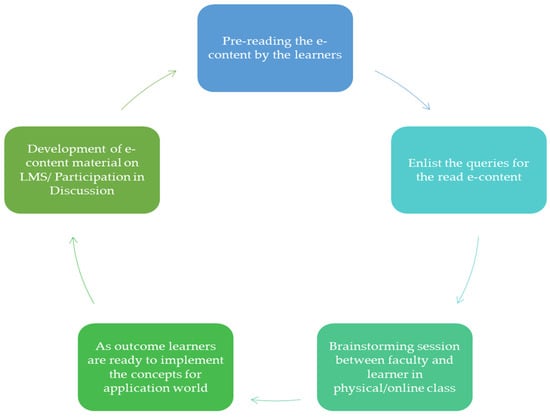
Figure 1.
Flipped Classroom conceptual procedure.
3.1.2. Problem-Based Learning
Problem-Based Learning (PBL) is an innovative group-based experiential learning method for special sessions, group projects, and group training. It has been demonstrated to improve students’ problem-solving skills for industrial preparedness [13]. Since 2020, conceptualizing and conducting PBL activities, also known as problem-based learning, has become complex owing to non-physical contact between mentee and mentor. However, the notions enable institutions to organize and help learners through e-learning, benefitting all learners greatly regarding flexible learning post-COVID-19 [14]. Figure 2 below shows the steps of PBL activities for learners to follow and implement post-COVID-19:
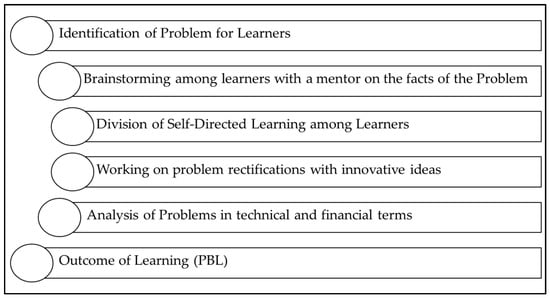
Figure 2.
Stages of Problem-Based Learning.
3.1.3. Cooperative Learning Methodology
Since COVID-19, higher education students have been diagnosed with academic diseases, including poor writing, reading, and exam performance. This has separated scholars into slow and fast learners. All engineering, business, and medical schools use CLM (cooperative learning methodology), which is a method to increase students’ talents, knowledge, and technical skills [15]. CLM divides students/learners into dynamic and non-dynamic groups. Dynamic learners have exceptional talents and transform non-dynamic students, involving them in discussion, performance, and action. Some essential advantages of cooperative learning methods are mentoring, high self-esteem, positive relationships, team building, effective communication, etc.
3.1.4. 4′Quadrant Approach
The four-quadrant model/approach to assisted learning, abbreviated as 4QM, is utilized by instructors and practitioners in selecting effective learning strategies based on learners’ changing needs as they acquire new abilities. Courses are organized into four different quadrants following the 4QM, offering learners four different forms: (1) e-tutorials, (2) e-content, (3) self-assessment, and (4) discussion forums, as mentioned in Figure 3.
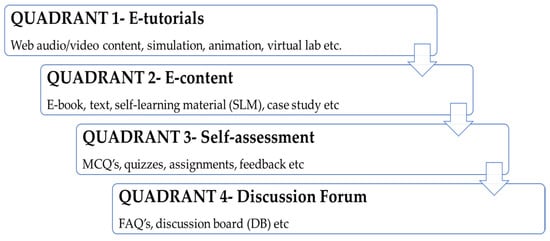
Figure 3.
4′Quadrant Approach in online learning.
Quadrant 1 e-tutorials include audio and video content by subject matter experts, simulations, animations., virtual labs, etc.; quadrant 2 includes e-content, which is carefully prepared reading material in the form of self-learning material or e-books that can be downloaded or printed; quadrant 3 is self-assessment in the form of tests, quizzes, assignments, feedback, etc.; and quadrant 4 includes discussion forums for clearing up any lingering questions or concerns relevant to the course. DB can be made in synchronous and asynchronous mode. Synchronous discussions lead with live timelines, and asynchronous discussions have their own pace and ease for learners and instructors.
3.2. Assessment Methods Adopted during COVID-19
3.2.1. Assessment and Evaluation Method
Academic institutions divide assessments into internal and external phases. Since COVID-19, most institutions have implemented online, hybrid, and offline A & E (assessment and evaluation) under examination protocols. Effective evaluation methods are demonstrated in Figure 4 below.
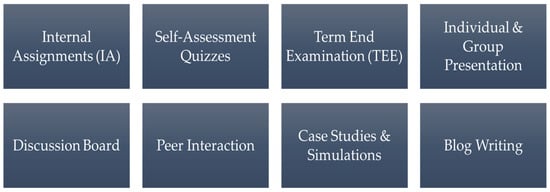
Figure 4.
Effective assessment and evaluation methods.
3.2.2. Outcome-Based Learning
Outcome-based learning/education is a familiar approach, but adopting it in physical, online, and hybrid academic settings is complex. However, educational institutions worldwide have embraced the OBL method to promote student-centered learning and assess students’ academic performance [16]. In broad terms, the institutions’ vision, mission, program outcomes, program educational objectives, and program-specific outcomes are correlated in a matrix with learning course outcomes and their difficulty level to determine learners’ program outcome attainment.
3.3. Comparative Analysis of Communication Methods in Higher Education
Different higher educational institutions use different kinds of communication methods for an improved learning approach. The comparative analysis of communication methods, such as traditional learning mode, flipped classroom, problem-based learning, and cooperative learning methodology, is explained in detail in Table 1 below [16,17].

Table 1.
Comparative analysis of different communication methods.
3.4. Adaptation of Hybrid Learning Methods: SWOT Analysis
The adaptation of hybrid learning methods has benefits and challenges simultaneously. Hybrid learning can provide students with a more holistic and progressive form of learning to complement today’s higher educational landscape. As we live in a highly connected world with ample opportunities to learn online/hybrid modes, we must shift from traditional methods to more innovative ones. The SWOT analysis given in Figure 5 explains how higher education institutions can adopt hybrid learning methods in better ways [17,18,19,20,21,22]:
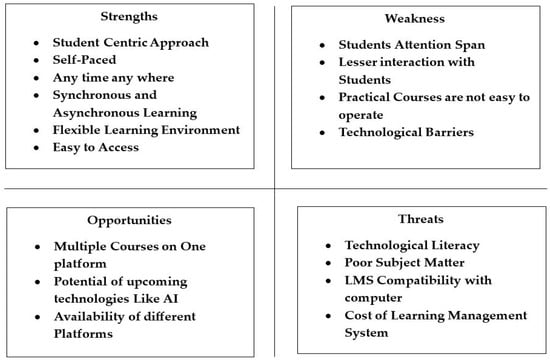
Figure 5.
SWOT Analysis for the adaptation of hybrid learning methods.
3.5. Modern Communication Methods in Effective Higher Education
Adopting innovative and modern communication is the key to a successful higher education system, assisting learners in forming their intellectual capital by helping them improve their creative and self-learning skills. Figure 6 explains the convergence of modern/online communication methods with traditional methods to make higher education more effective. This leads to a holistic modern education approach, which takes the following things into consideration: The purpose of holistic education should be knowledge development and reflecting the goals of life. For this, teaching pedagogy focuses on full engagement, which will adopt the hybrid mode of teaching. In this holistic approach, the learning process will focus on lifelong learning and skill-based learning, and outcomes will be the full personality development of learners and employability.
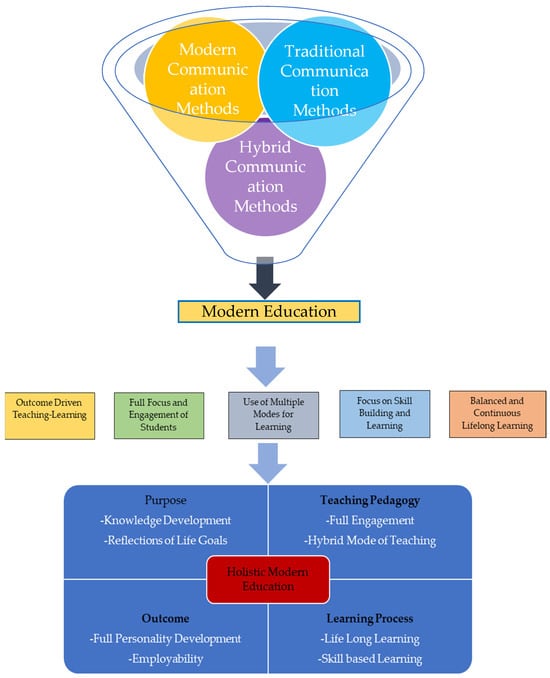
Figure 6.
Holistic approach model for effective higher education.
Thus, it can be said that the perfect blend of traditional and hybrid modes of communication can make teaching and learning more efficacious [23].
4. Conclusions
The COVID-19 pandemic has acted as an agent propelling higher education into a new era of communication methods. Online learning, flipped classrooms, problem-based learning, cooperative learning, and other innovative approaches have demonstrated their efficacy in enriching the learning environment, fostering engagement, and preparing students for the challenges of the digital age. While challenges remain, including faculty and student readiness, technological infrastructure, and equitable access, the positive impact of these methods must be addressed. As the higher education landscape evolves, a balanced blend of traditional and modern communication methods, supported by ongoing innovation and adaptability, promises to shape the future of education in once unimaginable ways. The pandemic has changed how we communicate in education and transformed it into a dynamic, inclusive, and student-centered endeavor.
Author Contributions
Conceptualization, B.; methodology, A.S.; validation, A.P.; formal analysis, B.; investigation, B.; original draft preparation, B.; writing—review and editing, A.S. and A.P.; supervision, A.P.; project administration, B. All authors have read and agreed to the published version of the manuscript.
Funding
No funds from any agency have been received to write the present research piece.
Institutional Review Board Statement
Not applicable.
Informed Consent Statement
Not applicable.
Data Availability Statement
This paper is solely based on secondary material; no primary data are available regarding this research.
Acknowledgments
My humble gratitude to the co-authors for their contribution, my family for extending their support constantly, and most importantly, environmental support from my institution, Manipal University Jaipur, for conducting the present research.
Conflicts of Interest
It is declared that there are no potential conflicts of interest concerning the research, authorship, and publication of this article.
References
- Pandey, A.; Savita Mishra, B. Learning Pedagogy in Higher Education, 1st ed.; Mittal Publications: New Delhi, India, 2022; pp. 11–32. [Google Scholar]
- Benson, A. Using online Learning to meet workforce demand: A case study of stakeholder influence. Q. Rev. Distance Educ. 2002, 3, 443–452. [Google Scholar]
- Conrad, D. Deep in the hearts of learners: Insights into the nature of the online community. J. Distance Educ. 2002, 17, 1–19. [Google Scholar]
- Butt, A. Student Views on Using A Flipped Classroom Approach: Evidence From Australia. Bus. Educ. Accredit. 2014, 6, 33–43. [Google Scholar]
- Yew, E.H.J.; Schmidt, H.G. Evidence for constructive, self-regulatory, and collaborative processes in problem-based learning. Adv. Health Sci. Educ. 2009, 14, 251–273. [Google Scholar] [CrossRef]
- Kim, K.-J.; Bonk, C.J. The future of online teaching and learning in higher education: The survey says. Educ. Q. 2006, 4, 22–30. [Google Scholar]
- McBrien, J.L.; Cheng, R.; Jones, P. Virtual spaces: Employing a synchronous online classroom facilitates student engagement in online Learning. Int. Rev. Res. Open Distrib. Learn. 2009, 10, 1–17. [Google Scholar] [CrossRef]
- Omar, A.; Liu, L.C.; Koong, K.S. From disaster recovery to mobile Learning: A case study. Int. J. Mob. Learn. Organ. 2008, 2, 4–7. [Google Scholar] [CrossRef]
- Singh, V.; Thurman, A. How many ways can we define Online Learning? A systematic literature review of definitions of Online Learning (1988–2018). Am. J. Distance Educ. 2019, 33, 289–306. [Google Scholar] [CrossRef]
- Song, L.; Singleton, E.S.; Hill, J.R.; Koh, M.H. Improving online Learning: Student perceptions of useful and challenging characteristics. Internet High. Educ. 2004, 7, 59–70. [Google Scholar] [CrossRef]
- Larson, S.; Yamamoto, J. Flipping the college spreadsheet skills classroom: Initial empirical results. J. Emerg. Trends Comput. Inf. Sci. 2013, 4, 751–758. [Google Scholar]
- Gilboy, M.B.; Heinrichs, S.; Pazzaglia, G. Enhancing student engagement using the flipped classroom. J. Nutr. Educ. Behav. 2015, 47, 109–114. [Google Scholar] [CrossRef]
- Hmelo-Silver, C.E. Problem-based learning: What and how do students learn? Educ. Psychol. Rev. 2004, 16, 235–266. [Google Scholar] [CrossRef]
- Strobel, J.; van Barneveld, A. When is PBL more effective? A meta-synthesis of meta-analyses comparing PBL to conventional classrooms. Interdiscip. J. Probl.-Based Learn. 2009, 3, 4. [Google Scholar] [CrossRef]
- Johnson, D.W.; Johnson, R.T. An Educational Psychology Success Story: Social Interdependence Theory and Cooperative Learning. J. Educ. Res. 2009, 38, 365–379. [Google Scholar] [CrossRef]
- Glatthorn, A.A. Outcome Based Education: Reform and the Curriculum Process. J. Curric. Superv. 1993, 8, 354–363. [Google Scholar]
- Pilli, O.; Admiraal, W.; Salli, A. MOOCs: Innovation or stagnation? Turk. Online J. Distance Educ. 2018, 19, 169–181. [Google Scholar] [CrossRef]
- Crouse, T.; Rice, M.; Mellard, D. Learning to serve students with disabilities online: Teachers’ perspectives. J. Online Learn. Res. 2018, 4, 123–145. [Google Scholar]
- Hampsten, K. Embracing discomfort resisting a return to “the good old days”: A call to communication educators. Forum: Pandemic pedagogy and student learning. Commun. Educ. 2021, 70, 208–210. [Google Scholar] [CrossRef]
- Wilke, D.; King, E.; Ashmore, M.; Stanley, C. Can clinical skills be taught online? Comparing skill development between online and F2F students using a blinded review. J. Soc. Work. Educ. 2016, 52, 484–492. [Google Scholar] [CrossRef]
- Akcil, U.; Bastas, M. Examination of university students’ attitudes towards e-learning during the COVID-19 pandemic process and the relationship of digital citizenship. Contemp. Educ. Technol. 2021, 13, 291. [Google Scholar] [CrossRef]
- Trammell, B.A.; LaForge, C. Common challenges for instructors in large online courses: Strategies to mitigate student and instructor frustration. J. Educ. Online 2017, 14, 1–10. [Google Scholar]
- Singh, J.; Steele, K.; Singh, L. Combining the Best of Online and Face-to-Face Learning: Hybrid and Blended Learning Approach for COVID-19, Post Vaccine, & Post-Pandemic World. J. Educ. Technol. Systems 2021, 50, 140–171. [Google Scholar] [CrossRef]
Disclaimer/Publisher’s Note: The statements, opinions and data contained in all publications are solely those of the individual author(s) and contributor(s) and not of MDPI and/or the editor(s). MDPI and/or the editor(s) disclaim responsibility for any injury to people or property resulting from any ideas, methods, instructions or products referred to in the content. |
© 2024 by the authors. Licensee MDPI, Basel, Switzerland. This article is an open access article distributed under the terms and conditions of the Creative Commons Attribution (CC BY) license (https://creativecommons.org/licenses/by/4.0/).